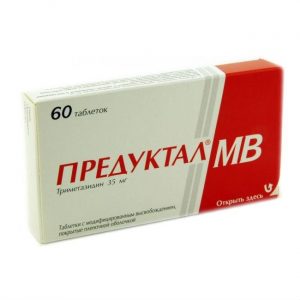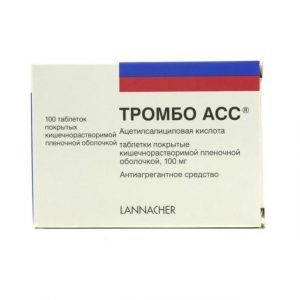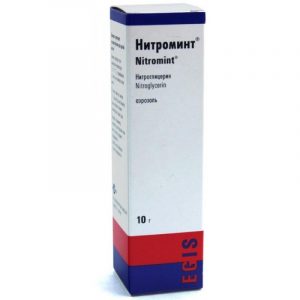Description
Release form
Film-coated tablets.
Packing
14 pcs.
Indications
Treatment of major depressive disorder in adults.
Contraindications
– Hypersensitivity to agomelatine and / or any of the excipients of the drug Valdoxan.
– Hepatic insufficiency (for example, cirrhosis or liver disease in the active phase) (see sections “Dosage and Administration” and “Special Instructions”).
– The simultaneous use of potent inhibitors of the isoenzyme CYP1A2 (such as fluvoxamine, ciprofloxacin) (see section “Interaction with other drugs and other types of interaction”).
– Children under 18 years of age (due to lack of sufficient clinical experience). In children and adolescents, while taking other antidepressants, suicidal behavior (suicide attempts and suicidal thoughts) and hostility (mainly aggressiveness, conflict behavior, irritation) were noted more often compared with the placebo group.
The drug should not be used in patients with lactose intolerance: lactase deficiency, galactosemia and glucose-galactose malabsorption.
WITH CAUTION. Elderly patients (65 years of age and older), with large depressive episodes in patients with moderate and severe renal failure, while prescribing agomelatine with moderate inhibitors of the CYP1A2 isoenzyme (such as propranolol, grefafloxacin, enoxacin), patients with manic or hypomanic episodes , patients with a history of suicide related events, as well as patients, who had suicidal intent before treatment, treatment of major depressive episodes in elderly patients with dementia (due to lack of data on the efficacy and safety of the drug in this group of patients).
Caution should be exercised when prescribing the drug to patients who consume significant amounts of alcohol or who take drugs that can cause liver dysfunction.
Special instructions
Elderly patients
Efficacy of the drug in elderly patients (aged 65 years and older) has not been established. There is limited data on the use of the drug Valdoxan ® for large depressive episodes in patients aged 65 years and older. When prescribing the drug to elderly patients, care should be taken (see section “Special instructions”).
Patients with renal failure
In patients with severe renal failure, there was no significant change in pharmacokinetic parameters. However, experience with the use of the drug Valdoxan ® in large depressive episodes in patients with moderate to severe renal failure is limited. When prescribing Valdoxan ® to such patients, caution should be exercised.
Bipolar Disorders / Mania / Hypomania
Caution should be exercised when using Valdoxan ® in patients with a history of bipolar disorders, manic or hypomanic episodes. If symptoms of mania appear, stop taking the drug.
Suicide / suicidal behavior
When depressed, there is an increased risk of suicidal thoughts, self-harm, and suicide (suicide-related events). The risk persists until a clear remission occurs. Patients should be under medical supervision until the condition improves (after the start of therapy, it may take several weeks before the condition improves). Clinical experience suggests that the risk of suicide may increase in the early stages of remission.
Patients with a history of suicide related events, as well as patients who had suicidal intent before starting treatment, are at risk and should be closely monitored during treatment.
The results of a meta-analysis of clinical trials of antidepressants in patients with mental disorders indicate an increased risk of suicidal behavior in patients under 25 years of age with antidepressants compared with placebo. During treatment, patients, especially those at risk, should be under close medical supervision, especially at the beginning of therapy and when the dose of the drug is changed. Patients (and their carers) should be informed about the need to immediately consult a doctor if the condition worsens, suicidal and unusual behavior, as well as when suicidal thoughts appear.
Joint use with inhibitors of the isoenzyme CYP1A2
Caution should be exercised while using agomelatine with moderate inhibitors of the isoenzyme CYP1A2 (such as propranolol, grefafloxacin, enoxacin) because of the possibility of increasing the concentration of agomelatine (see section ² ÑInteraction with other drugs and other drugs “).
Increased activity of transaminases in blood serum
Studies on the background of taking Valdoxan ®, especially at a dose of 50 mg, showed an increase in the activity of transaminases in blood serum (more than 3 times compared with the upper limit of normal) (see section “Side effects” “). As a rule, after discontinuation of therapy, these indicators returned to normal values. It is recommended to monitor liver function at the beginning of therapy and then periodically,
after 3 weeks, 6 weeks (end of the stopping period of therapy), 12 weeks and 24 weeks (end of the maintenance period of therapy) after the start of therapy, and then in accordance with the clinical situation.
With an increase in the activity of transaminases in the blood serum, a repeat study should be carried out within 48 hours. If the activity of transaminases is more than 3 times higher than the upper limit of normal, the drug should be discontinued. In the future, the functional state of the liver should be regularly monitored until the transaminase activity normalizes.
Caution should be exercised when prescribing Valdoxan ® to patients with increased transaminase activity prior to initiation of therapy (above the upper limit of normal, but not more than 3 times relative to the upper limit of normal). With the development of symptoms of impaired liver function, liver function tests should be performed. Based on laboratory data and the clinical picture, a decision should be made to stop or continue therapy with Valdoxan ®.
If jaundice develops, discontinue therapy. Caution should be exercised when prescribing Valdoxan ® to patients with risk factors for liver dysfunction, such as obesity / overweight / non-alcoholic fatty liver dystrophy, to patients who consume significant amounts of alcohol or who take drugs that can cause liver dysfunction.
Composition
1 tablet: – agomelatine 25 mg
Excipients: lactose monohydrate – 61.84 mg, magnesium stearate – 1.3 mg, corn starch – 26 mg, povidone – 9.1 mg, colloidal silicon dioxide – 260 mcg 3. sodium carboximet 3. carboxymeth mg, stearic acid – 2.6 mg.
The composition of the film membrane: glycerol – 196.65 ?g, hypromellose – 3. 26871 mg, iron dye yellow oxide – 195.09 ?g, macrogol 6000 – 208.72 ?g, magnesium stearate – 916.65 mg, titanium dioxide – 434.18 ?g.
Composition of blue paint: shellac, propylene glycol, indigo carmine aluminum varnish.
Dosage and Administration
Inside. Valdoxan ® tablets can be taken without regard to meals.
The tablet should be swallowed whole without chewing. If you skip taking the next dose of the drug, the next time you take
, Valdoxan ® is taken in the usual dose (you should not take the missed dose). To improve patient monitoring of drug administration, a calendar is printed on a blister containing tablets.
Recommended daily dose is 25 mg (1 tablet) once in the evening. In the absence of clinical dynamics after a two-week treatment, the dose can be increased to 50 mg (2 tablets of 25 mg) once in the evening.
It is recommended to monitor liver function at the beginning of therapy and then periodically, after 3 weeks, 6 weeks (end of the stopping period of therapy), 12 weeks and 24 weeks (end of the maintenance period of therapy) after the start of therapy, and further in accordance with the clinical situation.
Drug therapy for depression should be given for at least 6 months to completely stop the symptoms.
Discontinuation of treatment
If treatment is discontinued, there is no need for a gradual dose reduction.
Side effects of
In clinical trials, Valdoxan ® has been received by more than 3900 patients with depression.
Side effects were most often mild or moderate and were observed in the first two weeks of treatment. The most commonly reported nausea and dizziness. Reported side effects, as a rule, were transient and, basically, did not require discontinuation of treatment. In some cases, it is difficult to distinguish between symptoms of depressive disorder and side effects of agomelatine therapy.
The frequency of side effects of agomelatine is given in the form of the following gradation: very often (? 1/10), often (? 1/100, <1/10), infrequently (? 1/1000, - from the central nervous system Often: head pain, dizziness, drowsiness, insomnia, migraine Infrequently: paresthesia – From the gastrointestinal tract Often: nausea, diarrhea, constipation, abdominal pain. – From the hepatobiliary system Often: increased activity of ALT and / or AST ( more than 3 times compared with the upper limit of the norm on the background of taking agomelatine in 1.3% of patients and in 0.7% against the background of placebo). Rarely: hepatitis, increased activity of? -glutamyltransferase * (gamma-GGT) (more than 3 times compared with the upper limit of normal), increased activity of alkaline phosphatase * (more than 3 times compared with the upper limit of normal) . – From the skin and subcutaneous tissue Often: sweating. Infrequently: eczema, pruritus *. Rarely: erythematous rash. – From the side of the organ of vision Infrequently: blurry vision. – From the side of the musculoskeletal system Often: back pain. – Common Disorders Often: fatigue. – Mental Disorders Often: Anxiety. Infrequently: agitation and related symptoms *, such as irritability and anxiety, aggressiveness *, nightmares *, unusual dreams *. Rarely: mania / hypomania *. These symptoms may also be a manifestation of the underlying disease (see the “Special Instructions” section). Hallucinations *. Unspecified frequency: suicidal thoughts or suicidal behavior (see section “Special instructions”). * Estimation of the frequency of adverse reactions detected by spontaneous reports, carried out on the basis of clinical studies. Drug interactions Potentially possible effects of other drugs Agomelatine is 90% metabolized in the liver by cytochrome P450 1A2 (CYP1A2) and 10% by CYP2C9 / 19. Therefore, any drugs whose metabolism depends on these isoenzymes can increase or decrease the bioavailability of agomelatine. fluvoxamine, It is a strong inhibitor of the isoenzyme CYP1A2 and a moderate inhibitor of the isoenzyme CYP2C9 and significantly slows the metabolism of agomelatine, while the concentration of agomelatine increases by about 60 (12 – 412) times. Therefore, the simultaneous use of agomelatine and strong inhibitors of the CYP1A2 isoenzyme (such as fluvoxamine, ciprofloxacin) is contraindicated. The simultaneous administration of agomelatine and estrogens, which are moderate inhibitors of the isoenzyme CYP1A2, leads to an increase in the concentration of agomelatine several times. Although the combined use of agomelatine and estrogens was not accompanied by a deterioration in the safety profile of the therapy, caution should be exercised while prescribing agomelatine with other moderate inhibitors of the isoenzyme CYP1A2 (such as propranolol, grefafloxacin, enoxacin) until sufficient clinical experience has been gained (see Special Instructions ). Potential Potential Effect of Agomelatine on Other Medicines In vivo agomelatine does not induce cytochrome P450 isoenzymes. Agomelatine does not inhibit the CYP1A2 isoenzyme in vivo and other in vitro cytochrome P450 isoenzymes. Therefore, agomelatine does not affect the concentration of drugs whose metabolism is associated with these isoenzymes. Drugs that bind to plasma proteins to a large extent Agomelatine did not change the free concentration of drugs that bind to plasma proteins to a large extent and, in turn, did not affect the concentration of agomelatine. Other medicines The absence of pharmacokinetic and pharmacodynamic interaction of agomelatine and drugs, often used in the target patient population: benzodiazepines, lithium preparations, paroxetine, fluconazole and theophylline. Alcohol The use of agomelatine in conjunction with alcohol is not recommended. Electroconvulsive therapy (ECT) There are no data on the use of agomelatine simultaneously with ECT. Since agomelatine did not contribute to seizures in animal experiments, the undesirable consequences of the combined use of agomelatine and ECT are unlikely. Overdose Agomelatine overdose is limited. Symptoms: drowsiness, epigastric pain, anxiety, weakness, anxiety, agitation, tension, dizziness, cyanosis, malaise. When receiving patient agomelatine at a dose of 2450 mg, the condition normalized on its own, without disturbance of the cardiovascular system or changes in laboratory parameters. Treatment for No specific antidotes for agomelatine are known. Symptomatic treatment and monitoring in specialized units followed by observation. Storage Conditions In a dark place at a temperature not exceeding 25 ° C. Shelf life 3 years. Deystvuyushtee substance Aglomelantin dosage form tablets Possible product names VALDOXAN 0, 025 N14 TABLE P / FILM / SHELL Valdoxan tablet p / o 25mg N14 Valdoxan tab. p.p. 25 mg N14 Russia-France Valdoxan tablets 25 mg, 14 pcs. Servye, France




